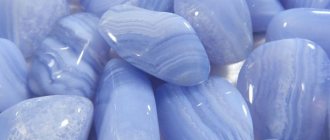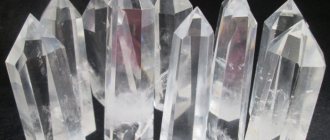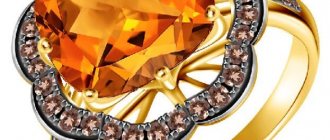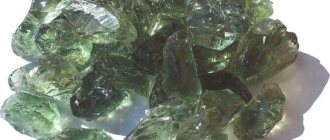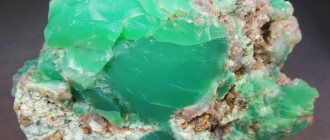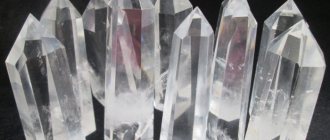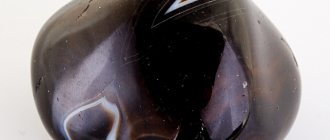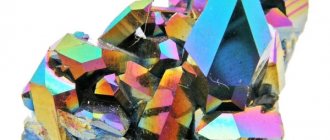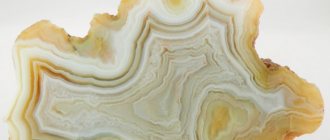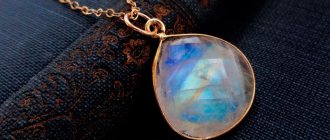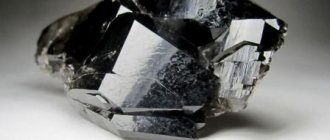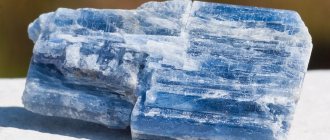Chalcedony
- a translucent mineral, a cryptocrystalline fine-fibered variety of quartz. Translucent or translucent at the edges, the color is very different, most often from white to honey-yellow. Forms spherulites, spherulite crusts, pseudostalactites or continuous massive formations. Banded chalcedony, consisting of layers differing in hue, transparency and density, is called agate. Since ancient times, multi-layered relief artistic images have been carved from homogeneous or parallel-banded sections of agate.
- Structure
- Properties
- Morphology
- Origin
- Application
- Classification
- Physical properties
- Optical properties
- Crystallographic properties
See also:
Chalcedony
- price and medicinal, magical properties
Physical properties and structure of diamond
History and origin
In ancient times, the skill of stone processing was highly developed. In Ancient Greece, gems were valued, imported for a long time, for the sake of whose possession wars were started. On the coast of the Sea of Marmara in the ancient Greek city of Chalcedon in Asia Minor (now part of modern Turkey), a deposit of quartz chalcedony, a wonderful stone distinguished by its richness of colors, was discovered.
The stone was named after the city where it was found.
Jewelry craftsmen made gems from chalcedony: cameos, seals, relief images on cabochons, where multi-layering and shades of the color of the stone were used.
Chalcedony stone
Glyptics is the art of carving miniature relief images on colored stones and gems: carnelian, agate, sapphirine. Stones processed in this way, with figures of people, birds and animals, allegorical images of military, religious and everyday scenes, were called gems. The image in a convex technique is a cameo, and a recessed one is an intaglio (seal).
Thanks to the color richness of chalcedony, master carvers created wonderful effects, enhancing them through inclusions and shades, tone transitions and color play.
The city of Chalcedon was destroyed by barbarians, and with the fall of the Ancient World, interest in the stone disappeared, returning to the era of classicism. Found during excavations in Roman cities, ancient gems were of historical value and works of jewelry art. High-ranking persons could allow themselves to be decorated by inserting them into a brooch, tiara or necklace.
Interest in objects of art from the ancient world did not fade away during the Empire period; European royalty had collections of glyptic works. The Hermitage collection contained thousands of cameos made by carvers of that time and from antiquity.
It is known that Napoleon had a chalcedony ring, like Byron, and Pushkin had two such rings.
Voloshin, at his dacha in the Crimea, loved to collect colorful pebbles on the sea coast; numerous guests of the Koktebel house took them away: Marina Tsvetaeva, Osip Mandelstam, Alexander Green, Andrei Bely, Alexey Tolstoy, Nikolai Gumilyov.
Physicochemical characteristics
Chalcedony is a type of quartz - SiO2, close to it in its physical and chemical properties.
| Formula | SiO2 |
| Color | Blue, yellow, gray |
| Shine | Waxy, matte |
| Transparency | Cloudy, translucent |
| Hardness | 6,5—7 |
| Cleavage | Absent |
| Kink | Uneven, less often shelled |
| Density | 2.58—2.64 g/cm³ |
Place of extraction
Quartz is a rock-forming mineral, one of the most common in the earth’s crust; in its free form its mass fraction is 12%, in other rocks it is 60%. Chalcedony, its fine-fibered cryptocrystalline variety, is a white-yellow transparent mineral.
Chalcedony
It is formed by crystallization from volcanic rocks at temperatures of 700–1000°C or under hydrothermal influences - water and high pressures.
Due to impurities and complex geological processes in the earth's crust, chalcedony can look different, but have the same physical and chemical characteristics.
The mineral can form spherulites and spherulitic crusts with a kidney-shaped surface, continuous massifs, veins and pseudostalactites. Due to its wide distribution, it is mined all over the world. The division according to the description of chalcedony is arbitrary, and varieties of this mineral can be found even on one stone: sarder with a transition to carnelian. They can coexist in the same mine, but mainly one type of chalcedony predominates in production.
Rich deposits: in Brazil, India, USA, Uruguay, Scotland, Germany, Australia. In Russia: Transcaucasia, Chukotka, Kolyma, Primorsky Territory, Crimea (Kara-Dag), Ural. A variety of chalcedony, sapphirine, can be found on the banks and valleys of the Lena and Yenisei rivers, on the Black Sea coast, as a secondary deposit.
MORPHOLOGY
Chalcedony forms dense masses, sintered forms, nodules, crusts, and fills voids. Chalcedony occurs in the form of crusts with an irregularly rounded, kidney-shaped or warty surface. It also forms sinter masses in cavities, stalactites, gradually turning into cluster-shaped and irregular sheet-like accumulations. Chalcedony is also observed in the form of individual kidney-shaped irregular or rounded nodules, formed either by concretion or as a result of weathering of rocks in which there were cavities filled with chalcedony. Sometimes it composes slag-like marsas, as well as small veins or cement in rocks.
Typically, chalcedony composes geodes and fills amygdaloid voids in altered basic igneous rocks; These chalcedony inclusions are often hollow and may contain liquid that has been plugged during crystallization. Chalcedony often forms encrusting pseudomorphs on other minerals, especially calcite and fluorite, and also replaces these and other minerals and fossil shells. The term “chalcedonic silica” has a broader meaning than chalcedony, which mainly refers to crustification formations and products of filling voids, represented by any fine-grained variety of quartz with a fibrous microstructure. This term is applied to continuous and nodular formations of primary sedimentary or diagenetic origin, including cherts and cherts, as well as accumulations resulting from the replacement of limestone and other rocks.
In chalcedony, more or less clearly visible banding is visible, parallel to the outer surface of the formations or the walls of the cavity. This banding is not always visible to the naked eye, but can be detected under a microscope in thin sections oriented perpendicular to the outer surface of chalcedony clusters, or it can be revealed by staining and etching.
Varieties and colors
Varieties of chalcedony have a bright individuality: color, properties, meaning and their own characteristics.
- Carnelian is a name of ancient Greek origin. The Latin name "carnelian", which means "dogwood berry", appeared due to its reddish color: red-brown, red-pink, yellow-red. The hue was formed due to hematite - red iron ore, sprayed with small particles. After exposure to sunlight, the density of the color of the stone changes - from shades of brown to orange. The stone is relatively inexpensive and available.
Cornelian - A variety of carnelian - sardonyx orange-red, black-red, white-brown, is highly valued and traditionally used in jewelry in carved items (eliminates fear of the future, calms). In ancient Egypt, this trefoil-shaped stone was considered a symbol of the mother goddess Isis. The carnelian amulet helped stop bleeding and protected against anger.
Carnelian stones - Sarder is reddish-brown, brown with red tints. It differs from carnelian only in shade. Pliny (1st century BC) described the technology for producing sard (an outdated term) from light chalcedony by annealing or boiling in a honey solution.
Sarder - Onyx is a ribbon chalcedony, a mineral with pronounced layering: red-brown, white with brown, black and red stripes, white with pink and yellow. There are small deposits in Chukotka, Kolyma and the Primorsky Territory on the Arabian Peninsula, India, Brazil, Uruguay, the USA, and in Russia.
Onyx - Chrysoprase is a variety of chalcedony highly valued for its color, unlike other chalcedony which is valued for its pattern or design. Nickel gave this stone a greenish or bluish-green color (usually the mineral is green due to chromium). Chrysoprase is highly valued by jewelers; depending on its characteristics, three varieties are distinguished:
- Emerald green - a rich, bright color with transparency of the stone up to 5 cm thick, homogeneous, small impurities are allowed - the highest grade.
- Emerald green chrysoprase
- Apple green, first grade, stone transparency up to 2 cm, with small opaque areas;
- Apple green chrysoprase
- Pale-colored - green-blue, yellow-green with impurities: spots, oxides and dendrites, areas with varying degrees of transparency are possible. The third grade is an ornamental stone.
- Pale colored chrysopras
Mining and processing of chrysoprase began only in the 16th century; the stone is very rare.
- Sapphirine is a bluish chalcedony of delicate shades obtained thanks to zircon (presumably). May turn pale when heated - fade.
Sapphirine - Heliotrope (bloodstone, bloody jasper) - dark green with bright red spots and stripes, looks exotic. Sometimes this variety of heliotrope is called plasma and has yellow spots. Pliny mentioned it in his works, calling it “turning with the Sun.” The mineral is valued by jewelers and collectors. The stones are used in men's rings and in the manufacture of cameos. In the Middle Ages, red splashes were given religious significance, associating them with the blood of Christ. Heliotrope was used in the manufacture of church utensils.
Heliotrope - Agate - consists of layers of different colors (the whole palette), transparency and density. Jewelers also call agate minerals that do not have a layered structure, but have a specific pattern: mossy and star-shaped. According to ancient legend, agate is the eye of a white eagle that fell to the ground after a battle with the Black Sorcerer. It is also called the Eye of the Creator, which looks at us, separating good and evil deeds.
Agate
The layering of agate gives diverse types:- Bastion - the structure of cracks and layers gives the effect of depicting a bastion - a city landscape.
Brazilian - the thinnest layers, up to 1.5 microns.
- Black, called magical.
- Mokhovaya - crystalline pattern creates branching contours.
- Star-shaped.
- Woody.
- Disk.
- Iridescent chalcedony has an optical shine effect - a blue-yellow-green iridescent metallic glow. Used for jewelry and decorative purposes.
Place of Birth
Among the many well-known locations of chalcedony are the following. At Trestieni, Transylvania, rhyolites contain veins and geodes, and sometimes cubic pseudomorphs on fluorite of light or dark blue chalcedony. In France, in many places in the Paris Basin, chalcedony nodules occur in gypsum and marble and accumulate in some soils, as well as in the Puy de Dome basalts of the Central Plateau. Fine examples of chalcedony are found in large quantities in the zeolite deposits of the Faroe Islands and in many places in the Deccan Traps development region of India. Significant accumulations of this stone are known in the agate deposits of Uruguay and the state of Rio Grande do Sul, Brazil; in Cuba, especially near Madruga in the province of Havana; in the Panama Canal Zone, as well as in many places in Panama, mainly in volcanic ash. Numerous occurrences of chalcedony are known in lavas along the shores of the Bay of Fundy in Nova Scotia. In the USA, beautiful pseudomorphs of chalcedony from corals and sponges are found in Tampa Bay, Hillsborough County, Florida. These pseudomorphs are usually hollow and covered on the inside with thin kidney-shaped chalcedony crusts. Chalcedony, along with agate and other varieties of microcrystalline quartz, occurs abundantly in association with felsic igneous rocks and volcanic ash in central Oregon, especially Crook County, and as rounded pebbles in the rivers and beaches of the Pacific coast and the state's Olympic Peninsula Washington. Chalcedony is known in large quantities in a number of places in Sweetwater county, Wyoming; in gravel deposits of the Yellowstone River in Montana; over a large area in Custer County, South Dakota. Chalcedony, colored various shades of red or orange by scattered cinnabar, or containing mottled accumulations of this mineral, occurs in Nye County, Nevada; in Jefferson County, Oregon; near Morton in Lewis County, Washington; at the New Almaden Mine in Santa Clara County and San Bernardino County, California, and many other locations. These chalcedony usually have a dull luster and are almost opaque, but transparent varieties are occasionally found.
Silicified wood is quite common, often with a chalcedony microstructure, sometimes it is brightly colored, has a fine-grained structure, and is related by gradual transitions to varieties of chalcedony commonly called jasper. There are well-known fossilized wood sites in the United States at Petrified Forest National Park near Holbrook in Arizona; in Yellowstone National Park in Wyoming; around Kittitas in Washington state; near Eden in Sweetwater County, Wyoming. In a good specimen of petrified wood, not only the external shape is preserved, but also the characteristic structure of the trunk (bark, wood and pith) with growth rings and medullary rays, and even the structure of the fiber, so that microscopic examination can often determine the species of this wood. Petrified wood may consist entirely of chalcedonic (or opalescent) silica or entirely or partially micrograined quartz. Sometimes the inside of each cell is occupied by a single quartz grain that does not have its own faces. The wood may have undergone petrification after partial decomposition, accompanied by disruption of shape and structure, or after transportation, during which the external parts were removed by abrasion. However, the internal features of the structure, and even the passages of the worms, are usually preserved. Hollow holes from tree trunks that were burned when exposed to hot lava or volcanic ash were discovered. These cavities are inlaid with chalcedony or crusts of colorless quartz or amethyst crystals. Silicified wood is commonly associated with volcanic ash, a substance that rapidly changes to release silica.
Medicinal properties
The abilities of so many types of chalcedony cannot but differ, united by a healing effect in some areas.
Chalcedony has a calming effect, will help normalize sleep, and relieve depression.
Jewelry with chalcedony is recommended for excitable, emotional people.
- Carnelian and carnelian will ensure good health and mood, relieve toothache, give freshness to the skin, and stop bleeding.
- Sarder helps restore the skin, heals wounds and ulcers. Helps in conception.
- Onyx takes care of the internal organs, especially the kidneys and liver.
- Chrysoprase smoothes out weather dependence. By charging water with a piece of stone for 5 hours in sunlight, you can use it for illnesses.
- Sapphirine increases blood pressure and helps normalize cardiac activity.
- Heliotrope normalizes the functioning of the cardiovascular system.
- Agate - for cough, toothache.
Products made from chalcedony should not be worn constantly.
Price
Chalcedony is not a very expensive stone, for example, yellow chalcedony (1.5 cm tumbling) costs 50 rubles. The cost of its varieties varies. For example:
- pendulum pendant (made of carnelian) - 105 rub. ;
- pyramid made of dark onyx (4 cm) - 172 rubles. ;
- heliotrope pendant - 290 rubles ;
- keychain with cacholong - 300 rub. ;
- tumbling (blue chalcedony) (2.5 x 3 cm) - 420 rub. for 1 piece ;
- Moss agate cabochon (62 x 43 x 4 mm) - 800 rub. ;
- chrysoprase bracelet (gilded jewelry) - 2,000 rubles.
Magic properties
The element of chalcedony is Earth. Sailors took it on long journeys, and the talisman helped them return home safely.
Chalcedony beads
Even in ancient times, using the magical properties of chalcedony, women attracted the attention and love of men: the stone did not leave their hearts indifferent. Chalcedony has been called the “stone of love”, “stone of joy”, it has positive energy - it removes melancholy and depression, and disperses melancholy.
The magical characteristics of chalcedony are associated with its healing beneficial effects, but they manifest themselves only with bright thoughts and a pure soul of a person.
Bright stones are the most energetically charged, and the color vibrations of the mineral correspond to the energy and character of the owner:
- red - movement and energy, protection;
- orange - acting, talent, beauty;
- blue shades - bring order to the mind, relieve anger,
- purple - willpower;
- green - patience, self-sufficiency;
- brown - stability, balance;
- purple - magic and enchantment;
- black is a symbol of birth and death.
Unprocessed chalcedony is a good amulet that preserves happiness and mutual love in the family. Helps develop harmony in intimate relationships.
Favorable time to buy
Chalcedony is calm under any moon. In order for the mineral to be charged with positive energy, it is better to purchase most stones when the month is growing.
It’s good when the shade of the stone or the purpose of the amulet is combined with the days of the week:
- On Monday - pale, blue stones for calm and balance, development of intuition;
- on Tuesday - red and purple to increase activity and determination;
- Wednesday is good for talismans of career and business growth, moving - golden and green palette;
- Thursday – for order, calm, regularity, stabilization – sand and brown colors;
- Friday - for love, these are red, pink and blue stones;
- Saturday for deep searches, meditation, working out internal problems - black and white, purple stones;
- Sunday is suitable for purchasing any amulet for yourself or your home.
It is customary to buy talismans for a birthday, wedding anniversary or memorable meeting, housewarming, name day. You need to buy chalcedony for yourself; it is given only to families or from parents to a child.
Who is suitable according to their zodiac sign?
Chalcedony has many faces and is suitable for everyone. You just need to find yours. A good way to do this is to consider the astrological connection between your horoscope sign and the stones.
Chalcedony bracelet
Check your intuition, is chalcedony your mineral?
| Zodiac sign | Compatibility |
| Aries | + |
| Taurus | + |
| Twins | + |
| Cancer | +++ |
| a lion | + |
| Virgo | + |
| Scales | + |
| Scorpion | + |
| Sagittarius | +++ |
| Capricorn | + |
| Aquarius | + |
| Fish | + |
(“+++” – fits perfectly, “+” – can be worn, “-” – is strictly contraindicated)
Chalcedony jewelry
Jewelry craftsmen make various jewelry from chalcedony. The assortment includes rings, earrings, necklaces, brooches, bracelets, and pendants.
The translucent structure makes the products elegant and mysterious. Also, the mineral has gained great popularity among craftsmen of fine work, because despite its elegant appearance it is inexpensive.
The jewelry can be worn on an important occasion, or you can simply wear it in everyday life.
Compatibility with other stones
There is a connection between the zodiac constellations and stones, which allows you to combine stones of friendly elements and prohibits - hostile ones, taking into account the friendship of the planets. Earth is the element of chalcedony, Earth is undoubtedly friends with Air, Water and Fire are antagonists.
Combining different colored stones at the same time is not the best solution, even if it does not contradict the principles of mineralogical astrology. When choosing a stone in jewelry that gives you warmth and confidence, see if it suits your eyes, skin color, hair? Does it look nice on you? Does it harmonize with your image? Natural stone has energy that is shared with the owner, and you share yours with him.
Wear it separately from other stones. Use a sense of proportion and intuition.
Variegated mix
The magical energy of a gem depends on the color. The brighter it is, the stronger the stone.
In ancient India and China, thick black agate was obtained by soaking the stone in a solution of honey and then calcining it over a fire.
For the Mongols, true (blue and gray) chalcedony were stones of joy, but their main task was protection from the evil eye and damage. But the ancient Greeks did not go on sea voyages without a chalcedony amulet.
Esotericists believe that unprocessed chalcedony has great magical potential. Processing the stone “cuts off” part of the magical power of the gem.
By the way, he was the Bishop of Rennes and was an anti-feminist. He considered women envious, greedy, gluttonous, lustful...
In Marbod's Lapidarium we read:
“The stone is chalcedony, which glistens with dull whiteness...
They wear a drilled stone on their finger or around their neck;
The one who wears it, they say, wins in the courts.”
Application
Chalcedony is a jewelry and ornamental stone. These minerals often come in interesting colors, sizes and shapes, with kidney-shaped and stalactite-like minerals being valuable to collectors.
Varieties of chalcedony, varying in purity, rarity and value, remain one of the most readily available materials. They are used in jewelry; cameos are made from high-quality and interesting specimens. From budget decorative and ornamental types, household products are produced: vases, tabletops, finishing tiles, mosaics.
Chalcedony beads
Products and jewelry made of chalcedony: beads, cufflinks; Due to its availability and beauty, it is used in the manufacture of figurines, furniture inlay, mosaics, and vases are made from it. Onyx is used in stained glass windows and lampshades.
How to spot a fake
The main materials for counterfeits are glass or plastic.
Several ways to spot a fake:
- The mineral (carnelian, agate) is heavier than imitations.
- Glass and plastic are good heat conductors. Hold the stone in your hands and make sure that the chalcedony remains cool.
- Natural stone is unevenly colored, with inclusions and defects.
- Calm natural colors differ from artificial ones.
Fake carnelian on the modern market is ordinary chalcedony and agates, polished and stained with iron nitrate.
Chalcedony beads
It is possible to distinguish such an imitation only by splitting the stone, since the color extends to a depth of 1–2 mm.
How to wear and care
Some recommendations for caring for chalcedony products:
- Store separately from other stones, or wrapped for safety. The surface of chalcedony can be damaged by stones with a higher density.
- Remove before training or other activities, it is easy to scratch.
- Protect from chemicals.
- Avoid sudden temperature changes.
- Do not clean using steam or ultrasonic cleaning.
- Cleaning the stone - with soapy warm water using a cloth, remove any remaining soap.
- Chrysoprase and sapphirines should be protected from direct sunlight and high temperatures to preserve color.
There are a lot of us!
Chalcedony is a group of minerals, a variety of translucent quartz.
Chalcedony itself is bluish, gray-blue or gray-white translucent. Occasionally it can be almost transparent.
Just the name for a group of gems bothers buyers. Therefore, the different colors of this multifaceted stone are designated by “personal names.”
Biruni wrote about the “Mocha stone” - green chalcedony, colored with inclusions of worm-shaped or scaly chlorite crystals.
There are more than a hundred varieties of gems. Here are some of them:
- Gray glass head ( chalcedonolite ).
- Onyx is chalcedony with a distinct layered structure.
- Carnelian is an orange-red chalcedony.
- Chrysoprase . Color ranges from apple green to emerald green.
- Plasma . Onion green to dark green variety. Often there are white and yellowish spots on the body of the stone.
- Agate is a striped chalcedony, a layered stone with a whimsical arrangement of layers. Mineralogists consider chalcedony to be the mother of all agates. And there are many varieties of agate.
- Toad stone is chalcedony with a pimpled surface resembling toad skin.
- Abacus is the name given to chalcedony in the form of flattened nodules in Japan.
- Engidros (water stone, water agate) is an agate amygdala or a one-color chalcedony nodule, partially filled with water.
Expert opinion
Semenishcheva Polina
Specialist in mineralogy. Graduated from St. Petersburg Mining University.
Interesting : even silicon can be considered a type of chalcedony.
Am I an agate?
Varieties of chalcedony were previously called agates
